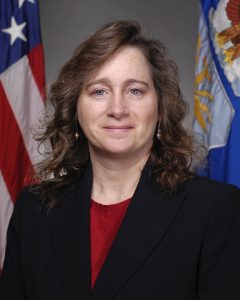By Kathleen Murray, AFCS Talent Acquisition Division —
You might think you know what a cost estimator is, that the job title is pretty self-explanatory. You probably envision a person who tells you how much a new timing belt will be, or what that kitchen renovation is going to set you back. But let me tell you, it is vastly more complex and interesting than I could have imagined.
I had a chance to speak with Ms. Ranae Woods, the Technical Director for the Air Force Cost Analysis Agency, and she opened my eyes to the possibilities of being a Cost Estimator for the Air Force Civilian Service (AFCS). The way she describes her position offers a glimpse into the sheer magnitude and variety and of what estimators do.
Being in AFCS allows you to work with cutting edge technology with the scope and scale of the entire Air Force. Woods tells me that in her role as technical director, she is the quality, technical review person for every product the Cost Agency develops. And they develop analyses and estimates for all major Air Force weapon systems, space programs and information systems. Woods makes sure that each one maintains the quality, consistency and accuracy that are her hallmarks.
“It’s fun though!” she assures me. “I get to see pretty much everything we develop and produce [in the Air Force] and be a part of that though doing the cost estimates. At AFCAA, we also get to push the state-of-the-art in cost estimating. My primary job is to help our analysts improve what they do, and improve the efficiency of what they do; to provide them the data, databases, methods and tools so that they can do the quality analysis we are asking of them. We’ve been on the cutting edge of that pretty much all the time.”
Cost estimators for AFCS have a tremendously wide-ranging skill set. Her team includes engineers of all types, people with business backgrounds, mathematicians, and accountants to mention a few. But, she says, the characteristic that really makes a great cost estimator is inquisitiveness.
“The good ones are always asking questions: wanting to find the root of a problem and figure out how to solve it, wanting to dig in, collect, and pull together data to do an analysis.”
Woods uses the words “analyst” and “estimator” interchangeably. Cost estimators must perform an analysis in order to produce an estimate.
“We look at all the emerging products and systems the Air Force wants to buy and do a cost analysis for what that future program will cost. Analysis is the process of getting a future product. It’s very complex.” In order to understand the elements you will be analyzing, you need math skills like calculus and statistics, data analysis, metrics, simulations and problem-solving.
Critical thinking and strong communications skills will lead to success and even leadership roles.
“A good analyst can go far in cost estimating. But if you combine great analysis with that critical thinking and can explain why your results make sense to someone who isn’t as analytical—maybe a decision maker or a program manager who doesn’t understand the science of the cost estimating process but needs to understand why the results make sense—that’ll take you far,” Woods explains.
I was surprised at how important communication was to the role. Being a cost estimator demands that you build relationships and talk to a lot of different people. You need to learn about everything from the material an aircraft is made from, to the manufacturing production line, to the payment structure of a contract. You have to be able to talk to the people involved in those processes.
“As the cost estimator, we have to consolidate all the pieces of a program into one so that we have a fully integrated picture of the whole program. We have to understand it all,” Woods said.
Woods has had the chance to work on a lot of cool projects with AFCS, from cargo aircraft that gave her access to a rich trove of historical data, to improving the manufacturing process of the F-22.
“It’s cutting edge,” Woods says. “You don’t think of the government as being part of the ‘cutting edge.’ you associate that with the private sector, but I get to see the cutting edge across all those contractors and what they’re all doing and how they’re doing it and what’s emerging in different areas versus seeing just what one area of the industry might be doing if I worked for a contractor/private industry.”
We spoke about what made working as a civilian for the Air Force an appealing option. And there are many reasons. What originally drew Woods to AFCS was the strength of the training program and the clarity of the steps AFCS lays out to allow you to progress in your career.
“They clearly lay out a plan for you to advance. I felt like I was interviewing for this job and where I would be going for the next five years,” she added.
AFCS also offers a deep commitment to work/life balance, not to mention the amazing federal benefits. But the strongest appeal, Woods says, is the sense of a shared mission.
“People who work here appreciate the feeling of contributing to the big picture. You can see what we’re doing and the difference it’s making. You see great products for people fighting the wars and preventing the wars. It makes you feel good.”
Interested in learning more? Want to be part of a mission that really matters? Sign up to be the first to hear about job opportunities at afciviliancareers.com


